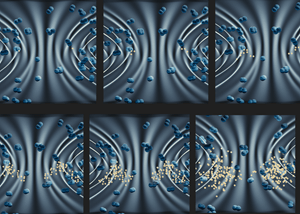Jun 21 2019
Scientists have formulated a new laser-based technique that can sense electric charges and chemicals of interest with unmatched sensitivity. The new method could soon be used in safety and security applications where large areas can be scanned for dangerous chemicals or radioactive materials.
 Artistic rendering of the avalanche process. Initial electrons present in the laser focus (black/white background) are accelerated and gain sufficient energy to liberate electrons from neutral air molecules (shown in blue). With time, the process repeats in a cascade, leading to a breakdown spark with many free electrons in the vicinity of each seed electron. (Image credit: E. Edwards/JQI)
Artistic rendering of the avalanche process. Initial electrons present in the laser focus (black/white background) are accelerated and gain sufficient energy to liberate electrons from neutral air molecules (shown in blue). With time, the process repeats in a cascade, leading to a breakdown spark with many free electrons in the vicinity of each seed electron. (Image credit: E. Edwards/JQI)
The new method, referred to as mid-infrared picosecond laser-driven electron avalanche, detects very low charge densities — the number of electric charges in a particular volume — in air or other gases. The scientists were able to compute electron densities in air formed by a radioactive source at levels below one part per quadrillion, corresponding to picking out one free electron from a million billion standard air molecules.
In Optica, The Optical Society's journal for significant research, scientists from the University of Maryland report using the new technique to calibrate lasers used to examine irradiated air from 1 m away. They say the method could be applied to sensing other chemicals and species and could be expanded for remote detection at distances of 10 m and, ultimately, 100 m.
We can determine charge densities much too low to measure with any other method. We demonstrate the method’s ability to detect a radioactive source, but it could eventually be used for any situation that requires measuring trace amounts of a chemical in a gas, such as helping to track pollution, chemicals or safety hazards.
Daniel Woodbury, Study Lead Author, University of Maryland
Detecting electrons in air
The new method is based on a process called electron avalanche wherein a laser beam quickens a single free electron in a gas until it gathers sufficient energy to push a different electron off a molecule, thereby freeing a second electron. This process repeats and forms into a collisional avalanche, or cascade, that grows exponentially until a bright noticeable spark forms in the laser focus.
Although laser-driven electron avalanche has existed since the 1960s, we used a new kind of high-energy, long-wavelength laser — a picosecond mid-IR laser — to enable detection of localized collisional cascades seeded only by the initial free electrons. When shorter wavelength laser pulses are used, the original free electrons seeding the avalanches are masked by free electrons generated directly by laser photons, rather than through collisions.
Howard M. Milchberg, Study Team Lead, University of Maryland
The study is based on the team’s earlier work, which showed that avalanche breakdown triggered by a mid-IR laser was sensitive to the density of electrons near a radioactive source and altered the amount of time it took for the breakdown to occur.
We conceived this method to remotely measure radiation near a radioactive source because the signals from Geiger counters and scintillators, conventional detectors of radioactive decay products, drop significantly at distances far from the source. With a laser beam, however, we can remotely probe electrons produced in air near the source.
Robert M. Schwartz, Student Researcher, University of Maryland
However, in their earlier experiments, it was difficult to establish precisely the number of electrons that were seeding a breakdown because the growth of the avalanche is exponential. “Ten, 100 or even 1000 electrons could all produce very similar signals,” said Woodbury. “While we could use theoretical models to give rough estimates, we couldn’t definitively say what electron densities we were measuring.”
In the new research, the team understood that, for the appropriate laser pulse length, the multiple breakdowns seeded by single electrons inside the laser focus would stay distinct. Capturing images of the laser focal volume and counting these sparks — each seeded by a single electron — is equal to calculating the density of these original seed electrons.
They learned that a mid-infrared laser (3.9-micron wavelength) having a 50-picosecond pulse duration hit the sweet spot with regards to wavelength and pulse duration.
Sensitivity plus location and time information
The scientists showed the feasibility of the detection concept by using it to measure charge densities created close to a radioactive source that ionizes the air. They measured electron densities down to a concentration of 1000 electrons/cm3, restricted by the background charge in air from naturally occurring radioactivity and cosmic rays. The technique was used to specifically scale their laser avalanche probe for remote detection of the radioactive source.
“Other methods are limited to approximately 10 million times higher concentrations of electrons with little to no spatial and temporal resolution,” said Milchberg. “Our method can count electrons directly and determine their location with a precision on the order of ten microns on time scales of about 10 picoseconds.”
The scientists say that the method can be used to compute ultra-low charge densities from different sources including robust field physics interactions or chemical species. “Pairing the picosecond mid-IR laser with a second laser that selectively ionizes a molecule of interest could allow the technique to measure the presence of chemicals with sensitivities far better than 1 part per trillion, the current limit for detecting very small concentrations in a gas,” said Woodbury. They will pursue this work to make the process more practical for application in the field.